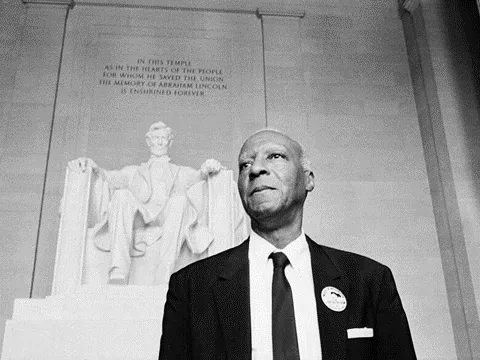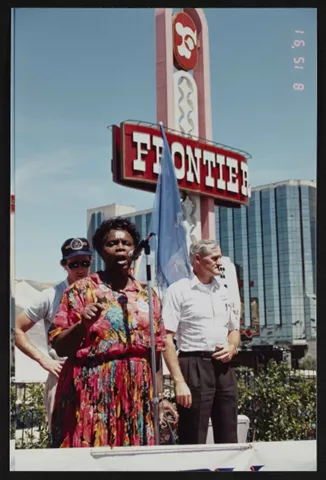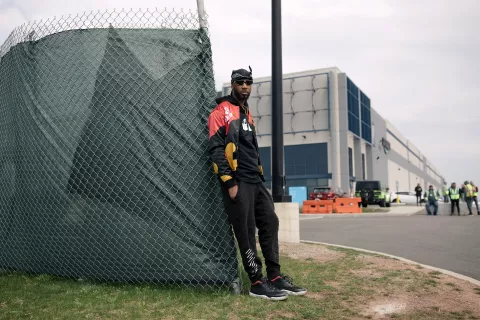Racial justice and economic justice are intrinsically intertwined. However, far too often in our nation’s history, those who benefit from the existing order have used race and class to divide us. These five Black leaders strengthened both the labor and civil rights movements by fighting discrimination in unions and building strong coalitions for the welfare of all.
Mary McLeod Bethune (1875-1955)

Born during Reconstruction to parents who had been enslaved, Mary McLeod Bethune grew up walking five miles to a Presbyterian mission school where a teacher noticed her dedication and recommended her for a college scholarship—setting Bethune on a path to change her career and the world.
In 1904, with $1.50 and five young students, the now-legendary Mary McLeod Bethune started a school for Black girls in Florida that became today’s Bethune-Cookman University. Two decades later, Bethune was elected as the first woman president of the National Association of Teachers in Colored Schools (NATCS), later renamed the American Teachers Association (ATA), which would eventually merge with the National Education Association to become the union we know today.
After serving as the NATCS president, Bethune would be appointed director of African American Affairs by U.S. President Franklin D. Roosevelt and later founded the National Council of Negro Women. Throughout her life, Mary McLeod Bethune broke through boundaries and used her platform to advocate for Black and women workers.
“I leave you a thirst for education. I leave you a respect for the use of power. I leave you faith. I leave you racial dignity. I leave you a desire to live harmoniously with your fellow men. I leave you, finally, a responsibility to our young people.
― Mary McLeod Bethune
A. Philip Randolph (1889-1979)

A. Philip Randolph was born in the late 1800s in Crescent City, Florida. He and his older brother attended Cookman Institute; an all-Black institution of higher education now known as Bethune-Cookman University. After graduation, he became involved in the movement for Black economic and social freedom in Harlem, New York.
In the summer of 1925, Randolph met with porters from the Chicago-based Pullman Palace Car Company. The mostly Black Pullman workforce were paid lower wages than white railway workers and faced harsh conditions and long working hours. Over the next ten years, Randolph worked with these workers to form and organize the Brotherhood of Sleeping Car Porters. When the union was finally recognized in 1937 it became the first predominately Black labor union in the nation.
Throughout the next forty years, Randolph continued to be a pioneer for the connected causes of racial and economic justice. During World War II, Randolph helped lead the fight to end discrimination in the defense industry and military, paving the way for Executive Order 8802, the Fair Employment Practices Commission, and the desegregation of the armed services. In the 1950s, Randolph served as one of the first two Black vice presidents of the new AFL-CIO and founded the Negro American Labor Council (NALC). Randolph was also one of the major organizers of the March on Washington for Jobs and Freedom in 1963, bringing together nearly 250,000 people to demand freedom and better lives through greater civil rights.
"Freedom is never granted: It is won. Justice is never given: It is exacted. Freedom and justice must be struggled for by the oppressed of all lands and races.”
— A. Philip Randolph
Bayard Rustin (1912-1987)

Bayard Rustin was born into a family of Quakers and activists in Pennsylvania. Growing up, his grandmother, Julia Rustin, was involved with the National Association for the Advancement of Colored People (NAACP) and his home was visited by Black leaders including W.E.B. Du Bois and Mary McLeod Bethune. He carried this upbringing with him, dedicating his life to the philosophy of nonviolence and the fight for human rights.
Rustin saw the interconnection between global struggles for racial, economic, and social justice. He played pivotal roles in the major movements of the second half of the 20th century, from co-founding the Congress of Racial Equality (CORE), combatting colonialism in India, Ghana, Nigeria, and South Africa, working for nuclear disarmament, leading the 1963 March on Washington, advocating for LGBTQ+ rights, organizing for worker empowerment, and demanding greater HIV/AIDS education. As a gay, Black man, Rustin was often pushed behind the scenes of these movements, his role in history too often forgotten.
As a member of the executive council of the AFL-CIO and a founder of the AFL-CIO's A. Philip Randolph Institute, Rustin fought against racism and discrimination in the labor movement. His leadership in these organizations focused on building diverse coalitions for the benefit of all humankind.
“We are all one. And if we don’t know it, we will learn it the hard way.”
—Bayard Rustin
Hattie Canty (1933-2012)

Hattie Canty was born near Mobile, Alabama, in 1933. When she moved with her family to Las Vegas in 1972, she felt that the labor movement continued the struggle for racial justice she had seen in Alabama, noting that the two were intrinsically linked.
In Nevada, Canty began working several jobs as a maid, a school janitor, and eventually a room attendant on the Las Vegas Strip. She became active in her union, was elected to the executive board of the Culinary Workers Union in 1984, and became union president in 1990. She was the first Black woman and the first room attendant elected to this position in CWU.
During her tenure, she brought together workers from 84 nations, helped push forward racial justice within the industry and her union, and founded the Culinary Training Academy, which helps people of color obtain better jobs in the hospitality industry. In addition, Canty served as president of the CWU during the longest strike in U.S. labor history, leading the workers at the Frontier Hotel through six and a half years of negotiations for better labor standards.
"Anytime I fight for anything in this labor movement, it benefits me in the civil rights movement."
— Hattie Canty
Chris Smalls (1988- )

Chris Smalls is a leader shaping the direction of the labor movement today. Born in New Jersey in 1988, he felt alienated from union establishments of the day, with his mother often forgetting she was a part of a union herself. It wasn’t until he started organizing his coworkers at Amazon that he saw how unions could be a vital vehicle for winning workers' rights.
Smalls started working at Amazon, optimistic about his path for development. However, over his years as an employee, he experienced grueling work expectations and saw institutionalized racism stop him and others from career growth. The tipping point was Amazon’s response to the COVID-19 pandemic, when it was clear his employers prioritized profit over the lives and wellbeing of him and his colleagues.
In March 2020, Smalls and his colleague Derrick Palmer began leading actions for Amazon worker rights. In April 2021, they began to call themselves the Amazon Labor Union (ALU). Even at that time, most of the country thought that unionizing Amazon staff was an impossible task. On April 1, 2022, the ALU proved doubters wrong – the workforce at the Amazon Staten Island warehouse JFK8 voted to establish a union. While this is just the beginning for Smalls and the ALU, this success is part of a new wave of union activism, pulling modern organizing tactics into the long legacy of fighting for labor rights.
“We don’t need millions of dollars. We just need the peoples’ power and the power of the community behind us.”
— Chris Smalls
